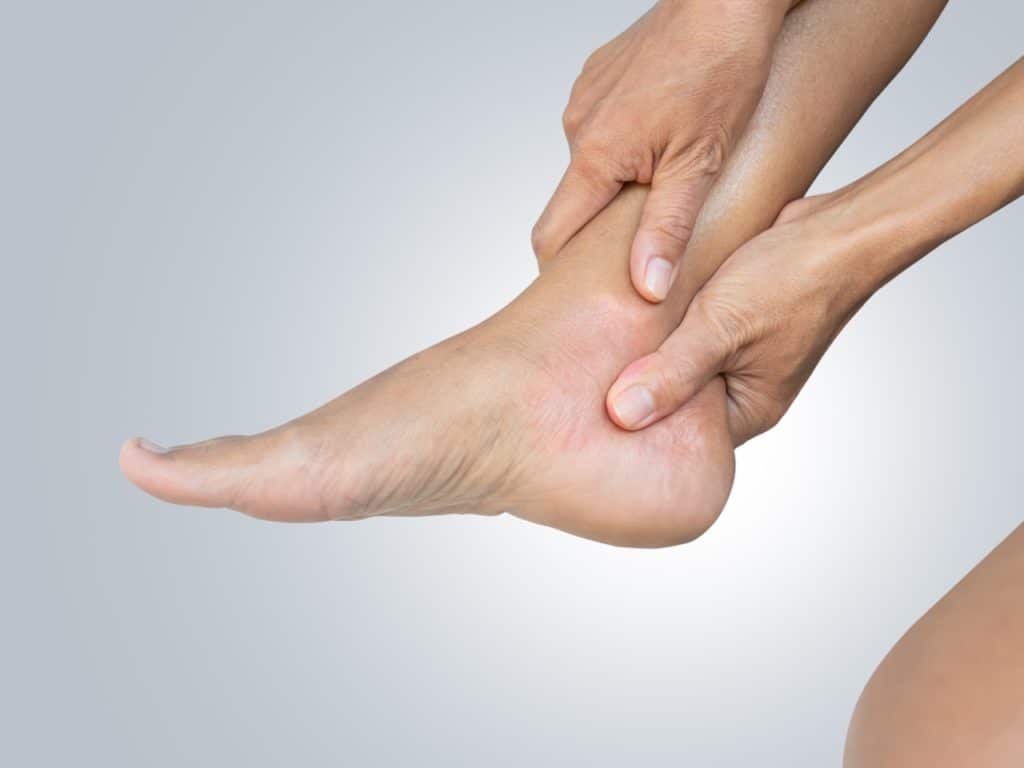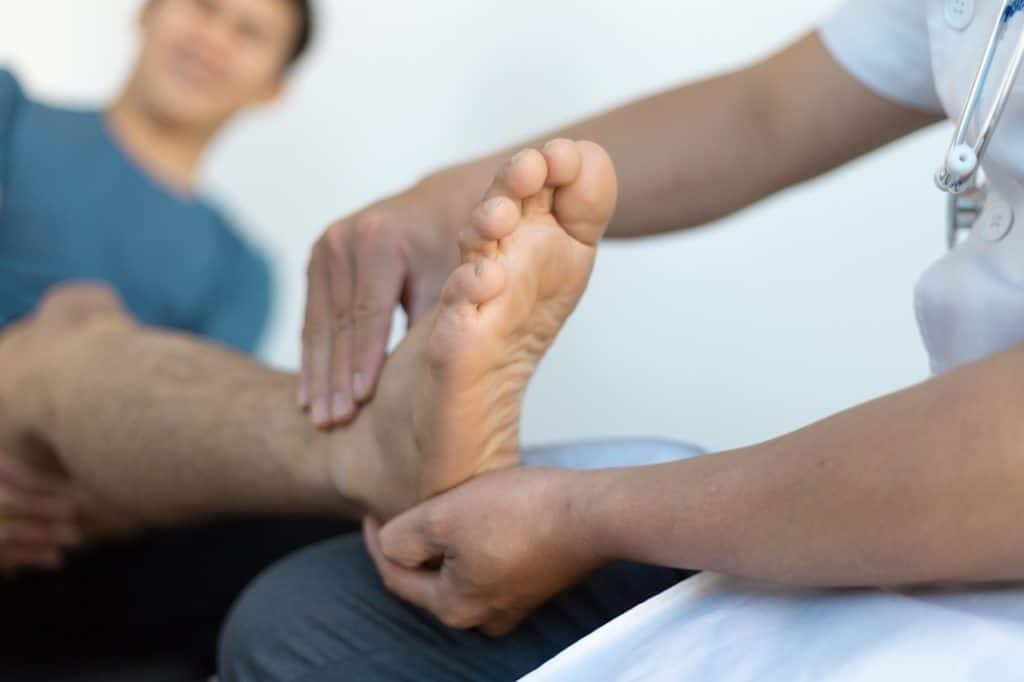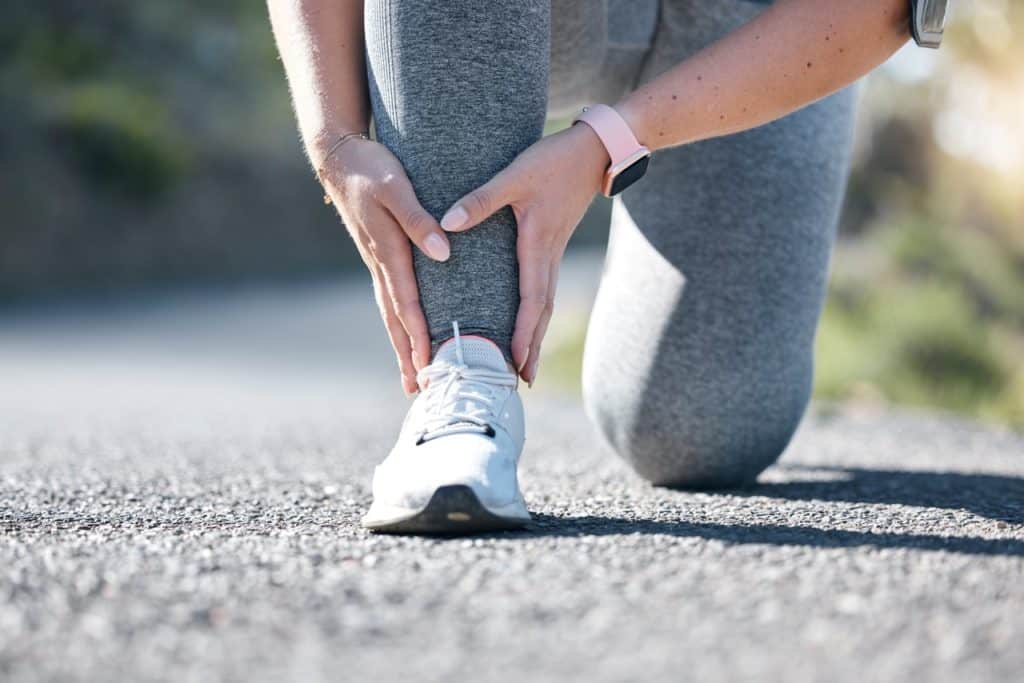Achilles pain is a common Achilles injury that runners face, especially during marathon training. It is caused by overuse and can be frustrating for runners who are trying to train for a big race. However, there are several effective strategies that can help alleviate Achilles pain from marathon training.
Understanding the Achilles tendon and its functions
Before diving into strategies to alleviate Achilles pain, it is important to understand the anatomy of the Achilles tendon and its functions.
What is the Achilles tendon, and its role in running and marathon training?
The Achilles tendon, the body’s thickest and strongest tendon, connects the calf muscles to the heel bone and plays a vital role in movement. It acts as a spring, storing energy upon ground contact and releasing it to propel you forward while running. However, when the tendon cannot stretch and contract efficiently, it becomes prone to overload injuries like Achilles tendinopathy.

Common causes of Achilles tendon pain in runners
Achilles tendon pain is a common issue for runners, often caused by overuse, improper footwear, and biomechanical factors such as flat feet or tight calf muscles. The Achilles tendon bears the impact of body weight, especially during running, making it vulnerable to injury. Overuse is especially prevalent among long-distance runners or those who abruptly increase their training intensity without allowing adequate rest and recovery.
The excessive strain placed on the tendon is the primary trigger for Achilles tendonitis. Contributing factors include weak calf muscles, limited ankle mobility, and overpronation, all of which can exacerbate stress on the tendon. Additionally, issues like poor hip mobility and inefficient running technique can play a significant role. High training volumes and other stressors ultimately lead to damage in the tendon fibres, making prevention and proper care essential for runners.
Identifying and managing Achilles tendinopathy
Achilles tendinopathy, commonly known as Achilles tendonitis, is a painful condition that affects the Achilles tendon – the large tendon at the back of our ankle connecting the calf muscles to the heel bone. It is one of the most common injuries among runners and can significantly impact training and performance.
While there are several contributing factors to Achilles tendinopathy, identifying and addressing them can help prevent and manage this injury effectively.
What is Achilles tendinopathy and its symptoms?
Achilles tendinopathy is a condition affecting the Achilles tendon, characterised by a non-inflammatory response to a sudden increase in load. Symptoms often ease after warming up but tend to return with prolonged running or weight-bearing activities involving the foot and ankle, leading to a painful tendon. A common complaint among those with tendinopathy is stiffness, particularly after periods of rest or upon waking in the morning.
Risk factors for developing Achilles tendinopathy
Several factors can heighten the risk of developing Achilles tendinopathy. A degenerative tendon can be structurally weaker and more prone to injury, making early intervention crucial to prevent further damage. These are divided into internal and external risk factors:
- Internal factors: Age, obesity, gender, a history of tendinopathy or prior injuries, and the use of certain medications can all contribute to an increased likelihood.
- External factors: Poor footwear choices, abrupt changes in training routines, limited ankle mobility, and improper foot biomechanics are key external contributors.
Understanding these risks can help in prevention and management strategies.
Internal and external risk factors for Achilles Tendinopathy
Achilles tendinopathy is a complex condition influenced by a variety of internal and external risk factors. Understanding these factors can help you take preventive measures and manage your condition more effectively.
Internal Risk Factors:
- Age: As we age, our tendons naturally undergo degeneration, making them more susceptible to injury.
- Obesity: Carrying excess weight puts additional stress on the Achilles tendon, increasing the risk of injury.
- Gender: Men are statistically more likely to develop Achilles tendinopathy than women.
- Previous tendinopathy or injury: A history of tendinopathy or prior injuries can make you more prone to developing the condition again.
- Diabetes: Individuals with diabetes are at a higher risk due to nerve damage and poor circulation.
- Medications: Long-term use of certain antibiotics or steroids can weaken tendons, making them more vulnerable to injury.
- Lower limb strength: Weak calf muscles and poor ankle mobility can contribute to the development of Achilles tendinopathy.
- Foot biomechanics: Abnormalities in foot shape or function, such as flat feet or high arches, can place additional stress on the Achilles tendon.
External Risk Factors:
- Footwear: Wearing shoes that lack adequate support or cushioning can increase the risk of Achilles tendinopathy.
- Training patterns: Sudden increases in the intensity or frequency of exercise can put excessive stress on the Achilles tendon.
- Running surfaces: Running on hard surfaces like concrete or asphalt can amplify the impact on your Achilles tendon.
- Running technique: Poor running form, such as overstriding or an abnormal gait, can place additional stress on the tendon.
By being aware of these risk factors, you can take proactive steps to protect your Achilles tendon and reduce the likelihood of injury.
Assessing and reducing Achilles load tolerance
The Achilles tendon is designed to withstand large amounts of load and stress, but it can only handle so much before it becomes strained. In order to prevent injuries, it is important to assess and monitor your Achilles tendons’ load tolerance. This involves understanding how much load your tendons can handle and implementing strategies to reduce excessive loads.
One way to assess your Achilles tendons’ load tolerance is through the use of a biomechanical analysis. This involves measuring factors such as ankle range of motion, running gait, foot alignment, and muscle strength. A professional physiotherapist can perform this assessment and provide personalised recommendations for improving load tolerance.
At Waverley Clinic, our experienced physiotherapist, James Leyland, specialises in providing comprehensive biomechanical assessments for Achilles tendon injuries. Whether you’re seeking expert diagnosis or effective treatment, we’re here to help.
Book your initial assessment online today or call our 24/7 appointment booking service at 01252 716611. Take the first step towards recovery with Waverley Clinic.
Guide to assessing general Achilles load tolerance
Evaluating your Achilles load tolerance is crucial for identifying appropriate activities and preventing further injury. Understanding this tolerance level helps you determine the ideal exercises and intensity for your recovery. A simple guide can provide clarity on optimising your workouts, but consulting a physiotherapist for a detailed biomechanical assessment and tailored treatment plan is highly recommended.
How to reduce the load on your Achilles tendon with proper footwear
Wearing the right footwear is essential for reducing load on your Achilles tendon. Here are some tips to keep in mind:
- Choose shoes with good arch support and cushioning, as they help to absorb shock and reduce strain on your Achilles tendon.
- Opt for shoes with a slightly raised heel, which helps to take pressure off the tendon and allows it to rest in a more relaxed position.
- Make sure the shoes fit properly, with enough room in the toe box for your toes to move comfortably. Tight-fitting shoes can increase stress on your tendons.
- Using heel-lifting inserts into your shoes can also help alleviate Achilles pain.
It’s also important to replace worn-out or ill-fitting shoes regularly. As a general rule of thumb, aim to replace running or workout shoes every 300-500 miles or every 6 months, whichever comes first. This will ensure that your feet and Achilles tendon are properly supported and protected during physical activity.

Treatment and recovery strategies for Achilles tendonitis
Achilles tendonitis is a common injury that can significantly hinder your physical activity and daily routine. Fortunately, there are several treatment and recovery strategies that you can implement to alleviate pain and promote healing.
Conservative treatments for Achilles tendonitis
There are several conservative treatments for Achilles tendonitis that can help alleviate pain and promote healing. Insertional Achilles tendonitis, a condition affecting many individuals, particularly runners, requires careful management of symptoms and specific rehabilitation guidelines. These treatments include:
- Rest, ice, compression, and elevation (RICE): are essential for minimizing pain and reducing inflammation.
- The eccentric heel drop exercise: is highly effective for treating Achilles tendon injuries. This exercise involves slowly lowering the heel while keeping the knee straight, helping to strengthen the tendon over time.
- A combination of shockwave therapy and a structured strength training programme: has also proven to be an effective treatment approach.

Aggressive treatments for Achilles tendonitis
In addition to rest and mild treatments like ice and compression, there are more aggressive treatment options available for Achilles tendonitis. Achilles tendon ruptures, which can occur due to high-risk activities such as running and other sports, often necessitate these aggressive treatments. These treatments are typically recommended for chronic cases or when conservative methods have not provided relief. Physical therapy, corticosteroid injections, and surgery are often more costly or time-intensive options. These treatments are typically reserved for managing chronic Achilles pain or cases where conservative methods prove ineffective.
The role of strengthening and plyometric exercises in recovery
Strengthening and plyometric exercises are an essential part of the recovery process for Achilles tendonitis. These exercises help to rebuild the strength and flexibility in the affected area, which is crucial for preventing future injury.
Here at Waverley Clinic, our Physiotherapist, James Leyland, often incorporates a range of strengthening exercises into their treatment plan for Achilles tendonitis. These may include calf raises, heel drops, and toe curls, among others. These exercises target the muscles in the lower leg, including the gastrocnemius and soleus muscles, which play a significant role in supporting the Achilles tendon.
Strengthening exercises play a crucial role in improving a tendon’s ability to handle load. Proper progression is key, beginning with isometric exercises, advancing to eccentric movements, and eventually incorporating plyometric training. This gradual approach ensures effective and sustainable improvement.
Plyometric exercises are also important for recovering from Achilles tendonitis. Plyometric training targets the stretch-shortening cycle within the tendon. These high-impact exercises involve explosive movements that can help improve muscle strength and proprioception, which is the body’s awareness of its position and movement. Some examples of plyometric exercises for Achilles tendonitis include active plant walk and A-skip. It is important to consult with a physical therapist or doctor before incorporating plyometrics into your exercise routine to ensure proper form and avoid further injury.
Cross-Training for Achilles tendon injury prevention
Cross-training, also known as cross-training or cross-fitness, is the practice of using a variety of different exercises and activities to improve overall physical fitness. It involves incorporating multiple types of movements, such as cardio, strength training, and flexibility work, into your workout routine.
Benefits of cross-training for runners with Achilles tendon injuries
For individuals dealing with Achilles tendonitis or looking to prevent it from occurring, cross-training can be highly beneficial. It allows you to continue exercising while avoiding overuse of the injured tendon and promoting proper healing.
Aqua jogging is the best form of cross-training for Achilles tendonitis, as it is zero-impact and safe for most injuries.
Best cross-training options: walking, swimming, cycling, and elliptical trainer
If aqua jogging isn’t an option for you, there are still plenty of other cross-training activities that can benefit individuals with Achilles tendon injuries.
Walking: is a great low-impact option that can help maintain cardiovascular fitness without putting too much strain on the injured tendon.
Swimming: is another excellent choice as it provides a full-body workout while also being low-impact. The weightlessness in the water takes pressure off the Achilles tendon, making it a safe and effective form of cross-training.
Cycling: is also a popular choice for cross-training, especially for those dealing with Achilles tendonitis. It allows for a good cardiovascular workout without putting excessive strain on the Achilles tendon.
Using an elliptical trainer: is another option for low-impact cross-training, as it mimics the motion of running without the impact on the joints.
Adjusting your running with Achilles tendonitis
If you are dealing with Achilles tendonitis, it is important to make adjustments to your running routine in order to allow for proper healing.
How to adjust your running speed, distance, terrain, frequency, and fatigue with Achilles tendinitis
- Running at higher speeds places greater strain on the Achilles tendon, potentially worsening Achilles tendonitis.
- Long-distance runs can lead to fatigue, pushing the tendon beyond its current strength and capacity.
- Running uphill, on steep inclines, or on soft surfaces like sand increases both the stretch and compression forces on the Achilles tendon.
Importance of listening to your body and taking rest days
Listening to your body and taking rest days when needed is crucial for preventing and managing Achilles tendinitis. Pushing through pain or ignoring discomfort can aggravate the condition and increase the risk of more severe injuries. Rest days give your tendon the time it needs to recover and strengthen, reducing the likelihood of further damage. They also allow other leg muscles to step in and share the load, easing strain on the Achilles tendon.
If running causes pain, consider making adjustments to minimise stress on your Achilles. Start by assessing your tendon’s load capacity using the guidelines provided and make necessary changes to your routine. If the pain persists or recovery feels unusually slow, don’t hesitate to consult a professional such as our physiotherapist James Leyland for expert advice. Prioritising rest and informed adjustments will help you protect your Achilles and maintain long-term mobility.
Returning to running after an injured Achilles tendon
Now that we have covered the common causes, symptoms and treatment for Achilles tendon injuries, let’s focus on how to safely return to running after sustaining an injury.
When can you return to running after an Achilles tendon injury?
Running can typically resume within the 12-week recovery period, provided the Achilles tendon shows no signs of irritation or flare-ups. To support the tendon, consider applying heat before running to loosen it up, and use ice afterward to reduce any potential swelling. If you’re planning to continue training for a marathon, it’s essential to consult a physiotherapist to manage discomfort and minimise risks. Strapping may also be a useful option to provide additional support.
How to gradually return to running after an Achilles tendon injury
Recovering from an Achilles tendon injury requires a careful and gradual approach to running to prevent re-injury or further complications. Start by slowly increasing your running distance and intensity over time, allowing your body to adapt. Incorporate strengthening and plyometric exercises into your routine to rebuild stability and resilience. Most importantly, listen to your body—prioritise rest when needed and avoid pushing through discomfort. Patience and consistency are key to a safe and successful return to running.
Preventing future Achilles tendon Injuries
Preventing future Achilles tendon injuries requires a combination of proper training, equipment, and self-care. Here are some essential tips to help you keep your Achilles tendon healthy and strong:
- Gradual Training Progression: Avoid sudden changes in your training intensity or frequency. Gradually increase your running distance and speed to give your Achilles tendon time to adapt.
- Proper Footwear: Invest in running shoes that offer adequate support and cushioning. Shoes with a slightly raised heel can help reduce stress on the Achilles tendon.
- Strengthening Exercises: Incorporate exercises that target your calf muscles and Achilles tendon into your training routine. Strengthening these muscles can improve their ability to handle load and reduce the risk of injury.
- Regular Stretching: Stretching your calf muscles and Achilles tendon can improve flexibility and reduce muscle tension. Make stretching a regular part of your warm-up and cool-down routines.
- Proper Running Technique: Focus on maintaining good running form. Avoid overstriding and ensure that your foot strikes the ground correctly to minimize stress on the Achilles tendon.
- Listen to Your Body: Pay attention to any signs of discomfort or pain in your Achilles tendon. Take regular breaks to rest and recover, and don’t push through pain.
By following these tips, you can significantly reduce the risk of future Achilles tendon injuries and continue to enjoy your running journey.
Preventing future Achilles tendon injuries
An Achilles tendon injury can be a frustrating experience, causing pain and limiting your ability to run or even walk comfortably. However, with proper treatment and rehabilitation, most people are able to return to their normal activities eventually.
Strategies for preventing future Achilles tendon injuries through proper training and recovery
How can you reduce the risk of future Achilles tendon injuries? Here are a few key tips:
- Include targeted Achilles exercises in your marathon training regimen.
- Gradually build up your running distance and intensity to avoid overloading your tendons.
- Pay attention to your body’s signals and take rest days when needed to prevent overuse injuries.
Equipment and gear for Achilles tendonitis
Choosing the right equipment and gear can play a crucial role in alleviating Achilles tendonitis symptoms and preventing future injuries. Here are some recommendations to help you make informed choices:
- Best Running Shoes for Achilles Tendonitis: Look for running shoes with a slightly higher heel stack or a temporary heel raise to reduce stress on the Achilles tendon.
- Orthotics and Shoe Inserts: Custom orthotics or shoe inserts can help redistribute pressure and reduce stress on the Achilles tendon. They provide additional support and can correct any biomechanical issues in your feet.
- Compression Sleeves and Wraps: Compression sleeves and wraps can provide support and stability for the Achilles tendon. They can also help reduce swelling and improve circulation.
- Foam Rollers and Massage Balls: Using foam rollers and massage balls can help reduce muscle tension and improve circulation in the calf muscles and Achilles tendon. Regular self-massage can aid in recovery and prevent stiffness.
Investing in the right equipment and gear can make a significant difference in managing Achilles tendonitis and preventing future injuries.
Final thoughts
Recovering from Achilles tendonitis requires patience, persistence, and a well-structured training programme. Here are some final thoughts to keep in mind as you work towards recovery:
- Patience and persistence in recovery and training: Recovery from Achilles tendonitis can take time, so be patient and stay committed to your training program. Consistency is key to achieving long-term results.
- Listen to your body: Pay close attention to your body’s signals. If you experience pain or discomfort, take a break and allow your tendon to rest and recover. Pushing through pain can lead to further injury.
- Gradually increase training intensity and frequency: Avoid sudden changes in your training program. Gradually increase your running distance and intensity to prevent excessive stress on the Achilles tendon.
- Incorporate strengthening exercises: Strengthening exercises for your calf muscles and Achilles tendon are essential for improving strength and reducing the risk of injury. Make these exercises a regular part of your routine.
- Seek professional help: If you’re experiencing persistent or severe Achilles tendonitis symptoms, seek professional help from a medical professional or a qualified running coach. They can provide personalised guidance and treatment to aid in your recovery.
By following these guidelines and staying committed to your recovery plan, you can overcome Achilles tendonitis and get back to running with confidence.
Book an appointment with Physiotherapist James Leyland for an Achilles pain assessment and finish your marathon training strong
Achilles tendon pain is a frequent concern for runners, but with the right training and recovery strategies, it can be both prevented and managed.
Incorporating targeted Achilles exercises into your marathon training can significantly reduce the risk of future injuries. Equally important is listening to your body—prioritising rest days when needed is essential for both recovery and injury prevention.
Experiencing Achilles tendon pain? Don’t let it hold you back from reaching your marathon goals. Book an appointment with our expert Physiotherapist, James Leyland today. With years of experience, James will assess your condition and provide tailored guidance to help you confidently tackle the final stages of your training.
Convenient booking options are available:
- Online: Book an appointment
- By phone: Call Waverley Clinic at 01252 716611 — our appointment line is open 24/7.
Take the first step toward recovery and get back on track with expert care.

